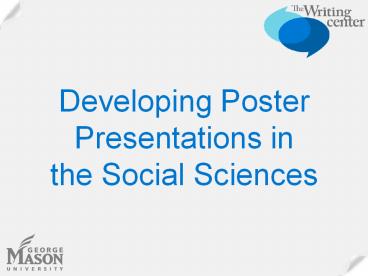Developing Poster Presentations in the Social Sciences - PowerPoint PPT Presentation
1 / 22
Title:
Developing Poster Presentations in the Social Sciences
Description:
Developing Poster Presentations in the Social Sciences Introduction Welcome to the online version of the Writing Center's Developing a Poster Presentation in the ... – PowerPoint PPT presentation
Number of Views:100
Avg rating:3.0/5.0
Title: Developing Poster Presentations in the Social Sciences
1
Developing Poster Presentations in the Social
Sciences
2
Introduction
Welcome to the online version of the Writing
Center's Developing a Poster Presentation in the
Social Sciences Workshop. Feel free to use the
arrow below to advance to the next slide, or you
can use the drop-down menu below to skip ahead.
3
Posters vs. Papers
Papers are designed to appeal to an editor of a
scholarly journal, and to meet the formal
organizational and informational requirements of
publication. Posters are designed to appeal to
peers and colleagues at conferences and/or public
displays, and to meet the organizational and
informational requirements of conferences and/or
public displays.
4
Posters vs. Papers
- The audience of a paper is a person the audience
of a poster is people. - A poster presentation allows for
question-and-answer sessions, and the exchange of
ideas and information regarding your research. - A paper presents all the information a poster
presents the most important information.
5
Elements of Your Poster
- Title
- Abstract
- Introduction
- Methods
- Data/Results
- Conclusions
- Acknowledgments
- References
6
Title
- Title
- Catching, simple, able to be seen from 20 feet
away. - Author(s)
- Always use first names.
- Use middle initials if space permits.
- Institution
- Institution and department.
- City names and state names can be dropped.
7
Abstract
Follow APA guidelines. Identify what is being
studied, how you are studying it, and what your
variables are. Identify your hypothesis.
State your findings.
8
Introduction
- Follow APA guidelines.
- Less in-depth than an introduction for a paper.
- Highlight and focus on
- Questions raised and answered by previous
research. - The question you are asking and why you are
asking it.
9
Methods
- Follow APA guidelines.
- Present only the basics--your audience isn't
trying to replicate your study at this moment,
they just want to know basic experimental design.
- Identify
- The demographics of your subjects.
- Measurement (repeated vs. independent).
- Design (between vs. within).
- Psychometric tests used in your experiment.
10
Data and Results
- Follow APA guidelines.
- Use graphic/visual elements
- Tables
- Charts
- Pictures
- Graphs
11
Data and Results
- Include a descriptive label for each graphic.
Below each graphic include a brief written
description of what the graphic is and the
interpretation of its data.
12
Conclusion
- Follow APA guidelines.
- Be concise and clear.
- Highlight
- What you found, and its importance.
- Parallels and discrepancies with previous
research and theory. - The direction of future research.
13
Acknowledgements
- Acknowledge those professionals and research
assistants outside of your research group that
contributed to your study. - Be brief.
- Note this section is not a requirement.
14
References
- Follow APA format.
- Use the same references as in your original
research paper.
15
Organization and Layout
- What does a poster look like?
- A general guide to poster layout
16
Organization and Layout
- Logistics
- Find out the size regulations before you
begin--the standard is usually 4' x 6'. - Font type for the body of your writing should be
large enough to read from 6 feet away.
17
Organization and Layout
- General Tips
- Organize materials in either a columnar or
counterclockwise fashion starting in the upper
left corner. - Make section headings distinct from the body of
your writing. - Use graphics, but only those that are necessary
18
Organization and Layout
- Fonts
- Use the same font style throughout the poster.
- The title should be readable from 20 feet away.
- The body of the writing should be readable from 6
feet away. - San serif fonts are easier to read.
- Add emphasis with bold, underline or
color--italics are harder to read.
19
Aesthetic Issues
- Color
- Used effectively, color is an effective method of
attracting people to your poster. - If you use color, stick to using a set number of
colors in a consistent pattern. - Limit your color use to 2-3 colors.
20
Aesthetic Issues
- Use contrasting colors for readability and a
professional look. - Mount your printed material (text and graphics)
on a colored background to create a border/frame.
21
Aesthetic Issues
- Layout
- Limited space doesn't mean you can cram things
together. - Use a consistent spacing rule between each
element of your poster. - Try to align corners along vertical and
horizontal lines.
22
Dont Forget
- You will be talking to others, and talking with
others, about your poster. Bring a copy of your
original paper for reference. Prepare handouts
that highlight the key points of your research.































